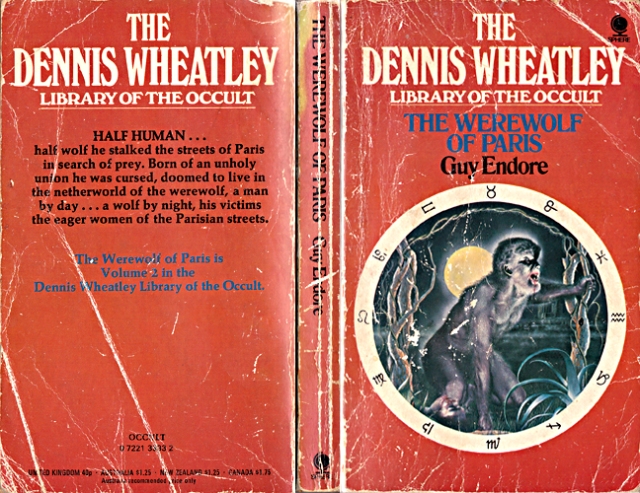So, Dennis Wheatley gave us Dracula as his opening gambit for the series; a bold move starting off with the most famous Vampire novel of all time. How could he follow that for the second book in his Library of the Occult, you may ask? By giving us the most famous Werewolf novel of all time, that’s how.
Endore’s 1933 novel is a fascinating thing; part Gothic romance; part horror; part historical fiction; it successfully intertwines factual events and people with the fictional protagonists to give us a bleak metaphorical discourse on the nature of humanity.
As you can see from the back cover blurb, this is being sold as a rather tawdry affair. It was very loosely adapted to film twice, by Hammer in 1961 and by Tyburn in 1975, both times being given the standard ‘creature feature’ treatment, which is a shame as this novel really is a long way from that.
Like all good Gothic novels Endore begins with a framing device to set the stage; this takes the form of a young American man living in contemporary Paris while diligently working towards his Ph.D. This unnamed young man is visited by Eliane, a friend from America, who convinces him to take her on a debauched tour of the Parisian nightlife. Here the central theme of duality which runs through the novel is introduced, he is reading Lucretius’ Epicurean text ‘De Rerum Natura’, she is reading the 1920’s sensational flapper novel ‘Flaming Youth’. He is sobre and serious, she is wild and intoxicated. He is guided by rationality, she is guided by instinct. He is decidedly human, she is rather wolfish.
It’s during this brief introductory chapter that our narrator discovers an old manuscript in a pile of litter. The manuscript turns out to be a report, written by Aymar Galliez, in defense of one Sergeant Bertrand Galliez for a court-martial dated 1871. Fascinated by this text, our narrator forms the body of our novel from his fleshed out investigations into the case.
The opening sequence of the main body of the novel gives us two castles, one on either side of a river, the great families of which are at constant war with each other. Now, there’s an image for the constant theme of duality. It’s about the battle between science and superstition, cruelty and kindness, savagery and civilisation, the rich and the poor. It’s to this violent world that is born Bertrand, the bastard son of an innocent 14 year old serving girl and the brutal priest who raped her during a thunderstorm. Of course, Endore has young Bertrand as the linch-pin of the novel; a character which, being both man and wolf, exists in a constant liminal state between these extremes.
We follow Bertrand and his adoptive uncle, Aymar, through that mid-19th century period of massive Gallic political turmoil. Beginning with Aymar’s injury in the brief 1848 revolution, through the Franco-Prussian war to the rise and fall of the Paris Commune, culminating in the terrors of the Bloody Week.
This is a true horror novel, in all senses. Endore appears to know his subjects well; the atrocities we become witness to during the battles for Paris, the battles between the new and old orders, are truly horrific and horrifically true. The wholesale slaughter, the executions, the paranoia led proletariat, the baying mobs, neighbours turning against neighbours, the wealthy corruptibles using the situation to their own advantage. The 20,000 or so people brutally killed during and following The Bloody Week. This is where the horror is and Endore, famously being a politically aware author, pulls no punches in depicting it.
Although this is a tale about a werewolf, the activites of the cursed Bertrand pale into insignificance when compared to the horrors surrounding him in a Paris at war with itself. In fact, the relationship between Bertrand and his lover Sophie, although marred by physicality, acts as a point of purity and sanity in an otherwise broken world. Bertrand’s wolfish behaviour is merely an instinctive need to feed, he becomes an innocent within the artifice of the political machinations surrounding him.
Ultimately, in the extraordinary bleakness of this novel, all pretence of duality is lost. Whether considered good or evil, a follower of science or superstition, rich or poor; we are all as one at heart. As soon as the thin veneer of civilisation has crumbled, we are all vicious beasts ready to rend and tear one another. We all have a vestigial beast within us.
We are all werewolves.


Your description of this book is fascinating, but I think I would have to be in a fair invulnerable mood of equanimity to tackle it.
LikeLiked by 1 person
Thanks, Lin. Yes, one of those books where you really do need to be sitting comfortably before you begin!
LikeLiked by 1 person
Excellent find old chap, your cover shot is amazing – those creases and signs of age just add to the beauty of the book. Can’t beat a bit of Wheatley either! Keep ’em coming, all the best.
LikeLiked by 1 person
Thanks, as always, for your comments. Yes, a bit of a creased and ragged edition, this one. I rescued it from a skip years ago; never ceases to amaze me how some people can just discard a book when they’ve finished reading it. A book is for life, not just for Christmas!!
LikeLiked by 1 person
I’m definitely putting this on my to-read list. The only book I have by Endore is ‘Satan’s Saint’, a novel about the Marquis De Sade. I haven’t read it, but what a title!
LikeLiked by 1 person
Werewolf of Paris is the only one of Endore’s I’ve read but I’d definitely read more on the back of it.
‘Satan’s Saint’ certainly sounds like a good place to continue!
Cheers.
LikeLike